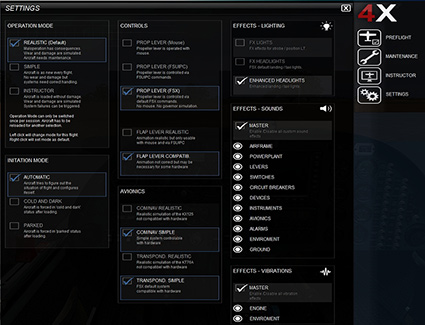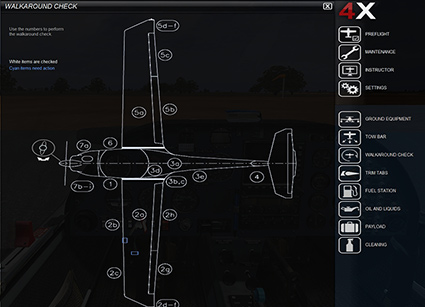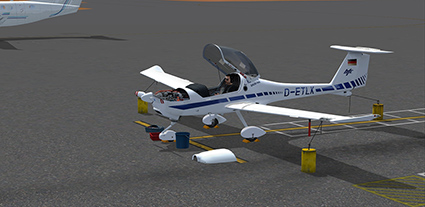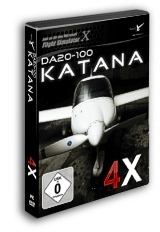I love flying small GA aircraft and when the
DA20 was released by Aerosoft I jumped at the chance to review it.
The DA20 is a two-seat tricycle gear aircraft that was designed
for flight training in a cival and military role, it is also very
popular with private pilots. The aircraft backs up the old
aviation saying that 'what looks good will fly good', as I hope
the screen-shots prove she is a beautiful looking aircraft.

About The Aircraft
The DA20 is different to other GA Aircraft because it features a
control stick instead of a yoke. It is also made of a composite
construction of glass and carbon-fibre reinforced plastic, a bubble
canopy which is fantastic for all around visibility and a castering nose wheel. The nose wheel took some getting used to as
you turn with differential breaking. The first DA20 rolled off the
production line in 1994 and have a base price of around $185,000 –
so Aerosoft's asking price of €27.95 isn't too bad! Owners of
Aerosoft's previous DA20 can upgrade for a reduced price.
What Do You Get?
It's a GA Aircraft, how can it possibly be a complex and in depth
simulation I hear you saying. My honest answer here is that if you
are going to buy this add-on with this mentality you will be in
for a very frustrating time. It is without a doubt the most
complex GA Aircraft I have flown in FSX. I'm not talking complex
FMC's and checklists, just in terms of basic operation. Aerosoft
boast that the DA20 has one of the most impressive feature lists
of any of their products. You have to maintain it, clean it,
refuel it and even decide which type of oil to use. I'll list a
few of the features below:
Airframe
|
Engine
|
Electrical System
|
Oil & Fuel System
|
Propeller
|
I've only scratched the surface here, I’m sure you will agree it has a very extensive list of features.
Download & Installation
As with all Aerosoft products this is a very easy process.
Purchase the DA20 via the download store, download the 180mb
file, run the installer and enter your email & serial number
when prompted and the DA20 will install using up 300mb of disk
space. It couldn't be easier and I wouldn't expect anything less
than this.
Living With The DA20


That might seem like a strange title, but I really feel like I
am living with this little aircraft. You have to think carefully
before carrying out an action because it may have catastrophic
consequences further down the line. As an example I didn't look
after the engine properly and destroyed it part way through a
flight, leading to an emergency landing in a field and having to
repair the engine via the maintenance panel before I could fly
again. It did take a while to become totally happy when flying
the DA20; it's not an aircraft that you can just jump in and go.
My initial problem was a huge left turning tendency during
flight; I would take off and fairly soon I would be in a 10-15
degree bank. There are various thoughts and comments about this
problem on the DA20 forum on the Aerosoft website, instead I
asked Mathijs Kok who advised to alter the rudder trim tabs
prior to take off – and it worked. I also found that loading a
passenger into the right seat helped with the balance too.
 Fuel Station |
 Sponge and Vacuum |
 Check Those Liquids |
Pre-flight with the DA20 is a straight forward affair but needs to be done to make sure everything is in working order, as in the real world. You can load up the pre-flight module within FSX and go through the external walk around ticking off the items as you go. Any items that need attention are highlighted in blue so you cannot miss them. It only takes 5 minutes but needs to be done. If you have the time prior to the pre-flight walk around I suggest running the maintenance module too just to be on the safe side.
Once the pre-flight is done you can proceed to taxi and take-off going through the check-lists. These are not included in the knee-board but there is a post in the DA20 Forum with a link to a file that puts them in the knee-board. Follow them through to the letter and if at any point something is not as it should be, head back to the parking area and run the maintenance module.

|

|
During flight you need to keep a careful eye on all the system temperatures or you will suffer an engine failure or massively reduced power. There does seem to be a common problem with the CHT temperature shooting through the red line quite often. From my own experience and reading a lot of forum posts it seems that it could be related to using the carburettor heat. I've found that by loading up the aircraft in the correct cold & dark start-up and not touching the carb heat at all seems to solve the problem. It does look like there may be an update on the way shortly to correct this problem. If the CHT temperature does begin to go up, or you start to loose power land as soon as you can, the engine will die on you.

|

|
Unlike any other aircraft I own if you do not fly the DA20 by the numbers you will cause damage to it. As a test I extended the flaps beyond their speed limitations and sure enough when I checked the maintenance module they were damaged and needed repairing. Other things like landing on round ground will damage the wheel fairings – so remove them prior to flight. The brakes will wear out over time if you use them too heavily, the oil will need changing and the aircraft will get dirty over time. Should you ever need to start from scratch a utility is included with the download to reset the aircraft configuration to make it new again. Alternatively you can run the aircraft in simple mode where where no wear and tear happens to the aircraft – as opposed to any damage being carried over to your next flight in realistic mode.

Equipment check |

Time for a service |

Workshop |
Documentation
The manuals provided for the DA20 are fantastic and tell you everything that you need to know – there is even a link on the DA20 Forums to a manual detailing everything you could possibly want to know about the Rotax engine and it's operation. For an aircraft that is as complex as this I was disappointed not to find a tutorial flight included with the documentation. Whilst it is enjoyable learning how to correctly operate the aircraft yourself, the first few flights I made were incredibly frustrating – a tutorial may have helped with this.
External Model & Sounds
Both are brilliant. Each and every lever has it's own sound and the constant hum of the engine during cruise is very therapeutic and a welcome change from the roar of some of the heavies I am used to flying. The external model is as smooth and sleek as the real thing; Aerosoft have done a wonderful job of re-creating the DA20 for the desktop.

|

|
![]()
Verdict
I've thoroughly enjoyed reviewing this add-on and it is a fantastic addition to your flight sim hangar. You
need to bear in mind that it is a complex aircraft (unless you run it in simple mode) and it may not be the
best add-on for the more casual simmer.
If you are unsure you can download the manual prior to purchase
to get an idea of what to expect. I did experience some teething problems which will hopefully be
addressed in a service pack, but the support available via the Aerosoft forums was a great help in sorting
any problems.
A tutorial flight would have been welcome and is a glaring omission from such a well
packaged product. I'm happy to award the Aerosoft Diamond DA20-100 Katana 4X-
Mutley's Hangar score of 8.5/10
*
*if the niggling problems are solved with a service pack it
is easily a 9/10
![]()
Review machine Spec: Intel Core2 Quad 2.40ghz | 4gb DDR2 RAM |Nvidia GForce 880GTX |Windows 7 64bit Home Premium

